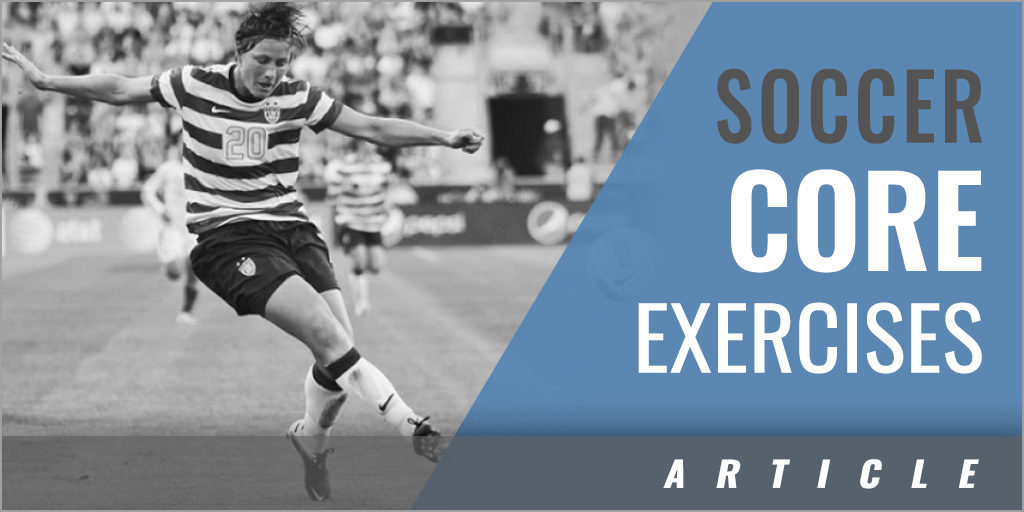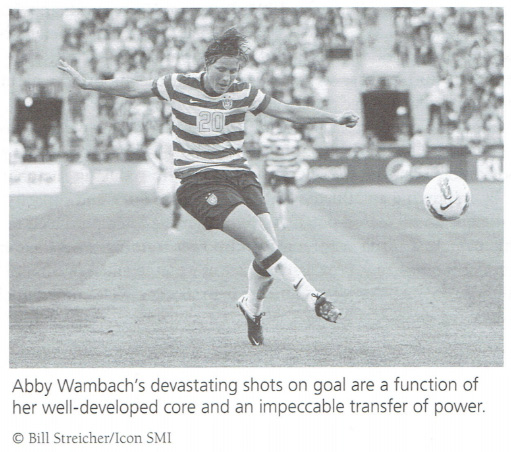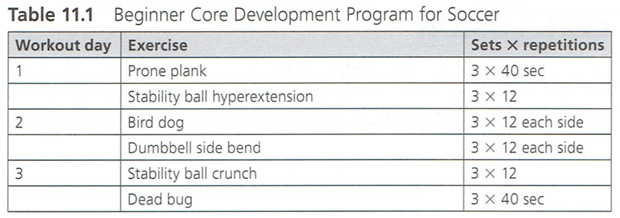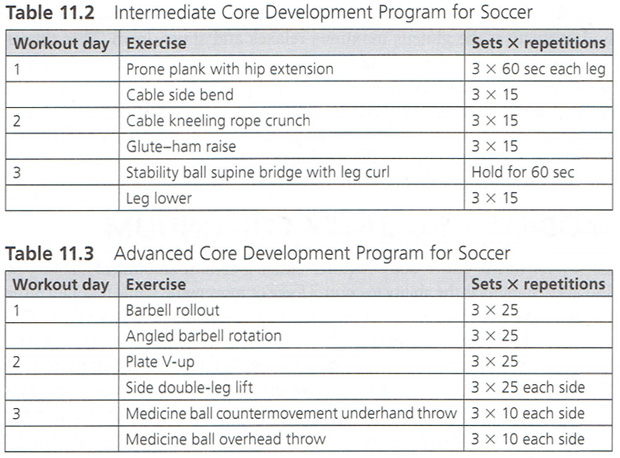|
By: Brijesh Patel Originally Published in: Developing the Core Provided by: Human Kinetics Soccer is the most widely played sport throughout the world. It is a game that is extremely demanding and is dependent upon many different athletic qualities. Speed, agility, power, quickness, flexibility, strength, and aerobic and anaerobic capacity are all qualities that must be trained in order to perform at the highest level. Soccer is played on a large field, over a 90-minute period and without regular rest periods. Players can cover 5 to 7.5 miles (8 to 12 km) during a game, consisting of 24 percent walking, 36 percent jogging, 20 percent pursuing, 11 percent sprinting, 7 percent moving backward, and 2 percent moving while in possession of the ball (Reilly 1996). Soccer athletes possess a large aerobic capacity, with VO2max levels reported between 55 and 70 ml/ kg/min in elite athletes (Bangsbo 1994; Bangsbo, Norregaard, and Thorsoe 1991). The game is played at an average intensity close to the lactate threshold - approximately 80 to 90 percent of maximum heart rate (Reilly 1996; Helgerud et al. 2001). These statistics demonstrate the importance of training both aerobic and anaerobic capacity in conditioning soccer athletes. Soccer in the United States is becoming increasingly more physical because of the emphasis on strength training, which plays a huge role in the ability to produce force and ultimately power but also in reducing the chance of injury. By improving an athlete's ability to produce force and capacity to do work, there is an increased potential to transfer the force produced to game performance. As a result of strength and power training, an athlete moves faster and becomes more explosive with more efficient movement. Well-conditioned core muscles are essential to help soccer athletes move efficiently and reduce the chance of injury. IMPORTANCE OF CORE DEVELOPMENT FOR SOCCER Soccer involves a number of different movements in all three planes. These movements are highly coordinated and require a great amount of energy transfer from the lower body through the trunk to the upper body. Without a stable trunk, the arms and legs cannot effectively execute powerful movements during competition. A stable trunk allows soccer athletes to maintain an upright posture and aids the respiratory system in providing the necessary airflow for maximal oxygen consumption, which contributes to optimal performance. Performing a variety of movements for the core improves players' ability to absorb external forces and reduces their risk of injury. The prescription of abdominal crunches or sit-ups alone may lead to muscle imbalances and kinetic chain deficiencies in the ability to absorb external forces and initiate rapid changes in direction. For example, sit-ups involve the rectus abdominis for the first 10 to 30 degrees of the exercise, while the remainder of the movement is aided by the hip flexors. Excessive shortening of the hip flexors causes the pelvis to tilt anteriorly, resulting in hyperextension of the lumbar spine and reciprocal inhibition of the gluteus maximus. Reciprocal inhibition occurs when a muscle on one side of a joint (agonist) is active and the opposing muscle on the other side of the joint (antagonist) relaxes to allow the agonist to perform the movement. In this situation, since the hip flexors are shortened and overactive, the gluteus maximus relaxes and shuts down. This causes compensatory activation of the hamstrings and lower back musculature to perform movements (running, walking, jumping). MOBILITY-STABILITY CONTINUUM Each joint in the entire body requires either a certain amount of stability or mobility. Stability is the ability to control force or movement, while mobility is the ability to move freely; good joint mobility requires the muscles around the joint to effectively contract and relax to allow smooth and fluid movement. The core consists of multiple joints, such as the intervertebral joints of the spine and the iliofemoral joints of the hips. Therefore the primary function of the core muscles is to provide stability, so that mobility can be better achieved in the joints of the upper and lower extremities and force can be transferred through these kinetic segments more efficiently. Good core muscle development for soccer involves a well-balanced approach that ensures spinal stability and hip mobility (McGill 2004). This approach helps prepare soccer athletes for the demands of the game. PROGRESSION Exercise progression is an often-overlooked variable in many programs. Failing to include progressions in fitness training increases the risk for injuries. The athlete must be able to perform each exercise flawlessly with control. Athletes should not be advanced into the next phase of exercises until they can perform the exercises in their current phase correctly. Tables 11.1 through 11.3 outline sample core development programs for beginner, intermediate, and advanced soccer players.
CORE EXERCISES UNIQUE TO SOCCER Core stability exercises can be added between soccer conditioning drills. For example, various types of planks can be performed on the grass field between bouts of interval-type conditioning. Since a stable core is critically important for lower extremity control when dribbling, passing, and kicking a soccer ball, players may incorporate various lower extremity movements (i.e., flexion, extension, abduction, adduction, internal and external rotation) in conjunction with the planks. Soccer ball throw-ins can be alternated with sets of medicine ball throws on the field to address different points along the force - velocity curve and train the core muscles for rapid rates of force development. CONCLUSION Core development for soccer athletes is much more than just getting on the floor and performing sit-ups. It takes a thoughtful approach to adequately prepare the core muscles for competition while also reducing the risk for injuries. |



 These improper recruitment patterns can lead to overuse injuries such as hamstring, hip flexor, and groin strains as well as lower back pain and, even worse, sports hernias. Therefore, it is important to take a balanced approach in the conditioning of the core musculature that contributes to optimal movement patterns.
These improper recruitment patterns can lead to overuse injuries such as hamstring, hip flexor, and groin strains as well as lower back pain and, even worse, sports hernias. Therefore, it is important to take a balanced approach in the conditioning of the core musculature that contributes to optimal movement patterns.




